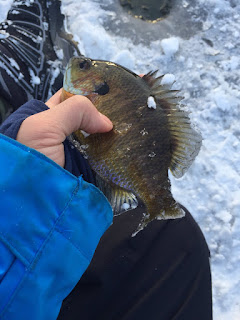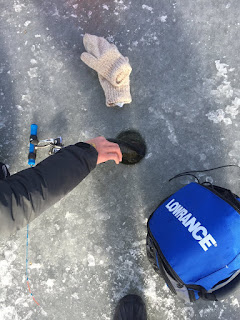Shallow Water Bluegill Setup
Shallow Water Bluegill Ice Fishing
As the ice starts to form on the bigger lakes and reservoirs of the Southern New York region, I am preparing my gear for the iced-over smaller lakes and ponds, which I know freeze over first. My beginning of the year spot, "King Lumber" on Muscoot Reservoir, freezes as soon as the temperature drops below 20 degrees at night for a week. "King Lumber", as anglers affectionately refer to the less than five acre cove, holds an early season ice bite, with plentiful bluegill, crappie, and perch. Most of the fishing at "King Lumber" is over shallow water weed-beds, and the rare 20ft sections that resemble the larger basins of larger lakes- "King Lumber" is a microcosm that resembles a larger lake.
During the early season, when pursuing bluegills in this over-pressured location, it is paramount that you develop a presentation that is unique from the countless other presentations that these fish have become accustomed to. One presentation that I find is underutilized is a very small jigging spoon - a Lindy Frosty jigging spoon or a Custom Jigs and Spins slender spoon in 1/16th ounce - on the treble hooks of these presentations, I always tip multiple spikes, or euro-larva, or a single waxworm or mealworm. It is important to keep the amount of bait that is put on the trebles of these spoons minimal, so as to not detract from the action of the spoon. To find a location to fish this technique, I will usually locate a point, walk out about fifty feet from shore, or where I am sure the water is deeper than seven feet, and then make holes every ten to fifteen feet. My first drop down the hole, I will aggressively jig the spoon 3/4 down the hole - raised far off the bottom. In this way, I ensure that I am not jigging inside the weeds, and letting the fish have an opportunity to eat my presentation. After I jig for about 1-2 minutes, I will stop my jigging cadence completely, allowing the frustrated panfish, that to this point is tantalized by my offering, to eat my bait.
If nothing has bitten my spoon, or if nothing appears on my flasher, then I adjust my location, deeper or shallower, in order to locate the fish. It is important to stay mobile to not only locate fish, but more importantly active and feeding fish(this sometimes means moving water bodies completely or moving across a water body). If fish rise off the bottom to investigate my offering, but they are shying away from eating my spoon, then sometimes I will increase the aggressiveness to which I am jigging, and although it seems counterintuitive - jigging more aggressively to lethargic fish - it is often the ticket to catching those lock-jawed bluegill. Another technique I often implement is to change, or increase or decrease, the type or size of worm that I am tipping the lure with - sometimes, crushing the worms to increase the scent released is also a way to get lethargic fish to bite.
It is important to note that constantly changing spots, away from unproductive locations is very time-effective, and increases the amount of distance that can be covered in a single fishing session. Furthermore, different schools of fish on different parts of the same water body can be in varying feeding moods. The conditions in one part of a lake: bottom substrate, depth, water clarity, weed growth, temperature can all be drastically different, especially in larger bodies of water. In this way, hole hopping is the best technique to locate feeding fish.
(Photo credits to Joe)
Paul and Joe- 12.27.2017(01/01/18)




Comments
Post a Comment